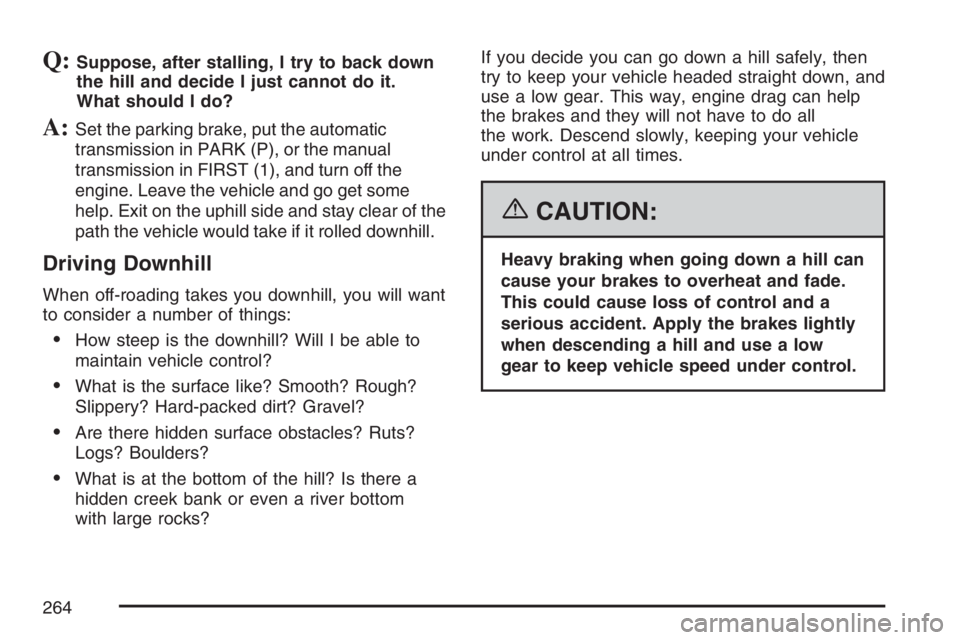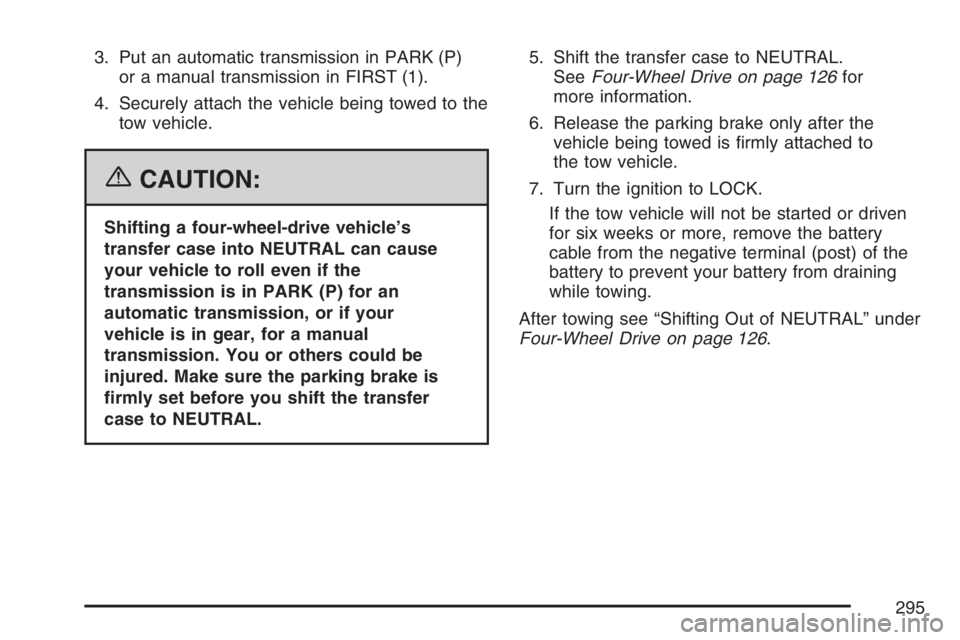Page 167 of 492

Headlamps on Reminder
If a door is open, a reminder chime will sound when
the headlamps or parking lamps are manually
turned on and your key is out of the ignition. To turn
off the chime, turn the headlamp switch to off and
then back on. In the automatic mode, the
headlamps turn off once the ignition is in LOCK.
If your vehicle was �rst sold in Canada and the
parking lamps are turned on manually, the Daytime
Running Lamps (DRL) will stay on.
Daytime Running Lamps (DRL)
Daytime Running Lamps (DRL) can make it easier
for others to see the front of your vehicle during
the day. DRL can be helpful in many different
driving conditions, but they can be especially
helpful in the short periods after dawn and before
sunset. Fully functional daytime running lamps
are required on all vehicles �rst sold in Canada.The DRL system will come on when the following
conditions are met:
The ignition is on.
The exterior lamps control is in AUTO.
The transmission is not in PARK (P) if you
have an automatic transmission.
The light sensor determines it is daytime.
Your vehicle will have either the parking lamps or
reduced intensity low beams used as the DRL.
When the DRL are on, only those lamps will be on.
The taillamps, sidemarkers, and other lamps will
not be on. The instrument panel will not be lit
up either.
When it begins to get dark, the headlamps will
automatically switch from DRL to the regular
headlamps.
As with any vehicle, you should turn on the
regular headlamp system when you need it.
167
Page 168 of 492

Automatic Headlamp System
When it is dark enough outside, the automatic
headlamp system will turn on after the
transmission has been shifted from PARK (P) to
DRIVE (D). The headlamps, taillamps, sidemarker,
parking lamps, roof marker lamps, and the
instrument panel lights will turn on at normal
brightness. The radio lights will become more dim
when the headlights are off compared to when
the headlights are on.
Your vehicle has a light sensor located on the
top of the instrument panel. Be sure it is not
covered, or the system will be on whenever the
ignition is on.
The system may also turn on the headlamps when
driving through a parking garage, heavy overcast
weather, or a tunnel. This is normal.There is a delay in the transition between the
daytime and nighttime operation of the Daytime
Running Lamps (DRL) and the automatic
headlamp system so that driving under bridges
or bright overhead street lights does not affect
the system. The DRL and automatic headlamp
system will only be affected when the light sensor
detects a change in lighting lasting longer than
the delay.
If you start your vehicle in a dark garage, the
automatic headlamp system will come on
immediately. Once you leave the garage, it will
take about one minute for the automatic headlamp
system to change to DRL if it is light outside.
During that delay, the instrument panel cluster
may not be as bright as usual. Make sure
the instrument panel brightness control is in the
full bright position. SeeInstrument Panel
Brightness on page 170.
168
Page 178 of 492
Instrument Panel Cluster
Your instrument panel cluster is designed to let you know at a glance how your vehicle is running. You will
know how fast you are going, about how much fuel you have used, and many other things you will need to
know to drive safely and economically.
United States automatic transmission version shown, Canada similar
178
Page 196 of 492

Automatic Door Locks
This feature allows you to program your door
locks to a preferred setting.
To set your choice for this feature, perform the
following steps:
1. With the engine off, turn the key to LOCK.
Do not remove the key from the ignition.
2. Press and hold the power door lock button for
about three seconds until the DIC display
shows the current door lock mode.
3. To view the next available mode, press and
hold the reset stem for about two seconds.
Release the reset stem and press and
hold again to view each mode.
4. Once the desired mode is shown on the DIC
display, brie�y press the reset stem to set
your choice. The DIC display will then clear.
The following are the available modes:
Lock 1 (default):On vehicles with an automatic
transmission, this mode locks all of the doors
when the vehicle is shifted out of PARK (P) and
unlocks all of the doors when the vehicle is shifted
into PARK (P).On vehicles with a manual transmission, this
mode locks all of the doors when the vehicle
speed is greater than 15 mph (24 km/h) and
unlocks all of the doors when the key is removed
from the ignition.
Lock 2:On vehicles with an automatic
transmission, this mode locks all of the doors
when the vehicle is shifted out of PARK (P) and
unlocks the driver’s door when the vehicle is
shifted into PARK (P).
On vehicles with a manual transmission, this
mode locks all of the doors when the vehicle
speed is greater than 15 mph (24 km/h) and
unlocks the driver’s door when the key is
removed from the ignition.
Lock 3:On vehicles with an automatic
transmission, this mode locks all of the doors
when the vehicle is shifted out of PARK (P).
The doors will not automatically unlock.
On vehicles with a manual transmission, this
mode locks all of the doors when the vehicle
speed is greater than 15 mph (24 km/h).
The doors will not automatically unlock.
196
Page 249 of 492

Remember: ABS does not change the time you
need to get your foot up to the brake pedal or
always decrease stopping distance. If you get too
close to the vehicle in front of you, you will not have
time to apply your brakes if that vehicle suddenly
slows or stops. Always leave enough room up
ahead to stop, even though you have ABS.
Using ABS
Do not pump the brakes. Just hold the brake pedal
down �rmly and let anti-lock work for you. You may
feel the brakes vibrate, or you may notice some
noise, but this is normal.
Braking in Emergencies
With ABS, you can steer and brake at the same
time. In many emergencies, steering can help you
more than even the very best braking.
Traction Control System (TCS)
Your vehicle may have a Traction Control
System (TCS) that limits wheel spin. This is
especially useful in slippery road conditions.
The system operates only if it senses that one
or both of the rear wheels are spinning or
beginning to lose traction. When this happens,
the system reduces engine power and may
also upshift the transmission to limit wheel spin.
You may feel or hear the system working, but this
is normal.
The TCS button is
located on your
instrument panel.
Press this button
to turn the TCS
off and on.
When the traction control system is turned off, an
indicator light on the button will illuminate.
If your vehicle is in cruise control when the traction
control system begins to limit wheel spin, the
cruise control will automatically disengage.
249
Page 250 of 492

When road conditions allow you to safely use it
again, you may re-engage the cruise control.
SeeCruise Control on page 163.
TCS operates in all transmission shift lever
positions. But the system can upshift the
transmission only as high as the shift lever position
you have chosen, so you should use the lower
gears only when necessary. SeeAutomatic
Transmission Operation on page 120and/or
Manual Transmission Operation on page 124for
more information.
If there is a problem with TCS, TRACTION FAULT
will be displayed on your Driver Information
Center (DIC). SeeDIC Warnings and Messages
on page 198for more information.
When this warning is displayed, the system will
not limit wheel spin. Adjust your driving
accordingly.
To limit wheel spin, especially in slippery road
conditions, you should always leave TCS on.
But you can turn the system off if you ever
need to. You should turn the system off if
your vehicle ever gets stuck in sand, mud or
snow and rocking the vehicle is required.SeeRocking Your Vehicle to Get It Out on
page 284andIf Your Vehicle is Stuck in Sand,
Mud, Ice, or Snow on page 284for more
information.
Adding non-GM accessories can affect your
vehicle’s performance. SeeAccessories and
Modi�cations on page 316for more information.
Limited-Slip Rear Axle
If your vehicle has this feature, your limited-slip
rear axle can give you additional traction on snow,
mud, ice, sand or gravel. It works like a standard
axle most of the time, but when one of the
rear wheels has no traction and the other does,
this feature will allow the wheel with traction
to move the vehicle.
Steering
Power Steering
If you lose power steering assist because the
engine stops or the system is not functioning, you
can steer but it will take much more effort.
250
Page 264 of 492

Q:Suppose, after stalling, I try to back down
the hill and decide I just cannot do it.
What should I do?
A:Set the parking brake, put the automatic
transmission in PARK (P), or the manual
transmission in FIRST (1), and turn off the
engine. Leave the vehicle and go get some
help. Exit on the uphill side and stay clear of the
path the vehicle would take if it rolled downhill.
Driving Downhill
When off-roading takes you downhill, you will want
to consider a number of things:
How steep is the downhill? Will I be able to
maintain vehicle control?
What is the surface like? Smooth? Rough?
Slippery? Hard-packed dirt? Gravel?
Are there hidden surface obstacles? Ruts?
Logs? Boulders?
What is at the bottom of the hill? Is there a
hidden creek bank or even a river bottom
with large rocks?If you decide you can go down a hill safely, then
try to keep your vehicle headed straight down, and
use a low gear. This way, engine drag can help
the brakes and they will not have to do all
the work. Descend slowly, keeping your vehicle
under control at all times.
{CAUTION:
Heavy braking when going down a hill can
cause your brakes to overheat and fade.
This could cause loss of control and a
serious accident. Apply the brakes lightly
when descending a hill and use a low
gear to keep vehicle speed under control.
264
Page 295 of 492

3. Put an automatic transmission in PARK (P)
or a manual transmission in FIRST (1).
4. Securely attach the vehicle being towed to the
tow vehicle.
{CAUTION:
Shifting a four-wheel-drive vehicle’s
transfer case into NEUTRAL can cause
your vehicle to roll even if the
transmission is in PARK (P) for an
automatic transmission, or if your
vehicle is in gear, for a manual
transmission. You or others could be
injured. Make sure the parking brake is
�rmly set before you shift the transfer
case to NEUTRAL.5. Shift the transfer case to NEUTRAL.
SeeFour-Wheel Drive on page 126for
more information.
6. Release the parking brake only after the
vehicle being towed is �rmly attached to
the tow vehicle.
7. Turn the ignition to LOCK.
If the tow vehicle will not be started or driven
for six weeks or more, remove the battery
cable from the negative terminal (post) of the
battery to prevent your battery from draining
while towing.
After towing see “Shifting Out of NEUTRAL” under
Four-Wheel Drive on page 126.
295